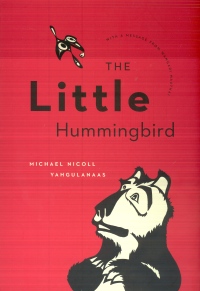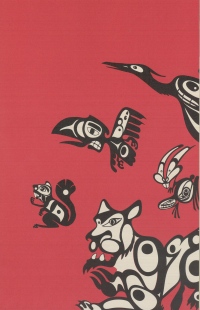| ________________
CM . . .
. Volume XVIII Number 8. . . .October 21, 2011
excerpt:
Michael Nicoll Yahgulanaas is a visual artist, illustrator, and environmental activist. He is also the Audain professor of Contemporary Art at the University of Victoria and the creator of Haida Manga – a felicitous hybrid of the Japanese-style graphic novel and Haida design. His graphic novel, Red, is based on Yahgulanaas’ astonishing series of murals which is a retelling of a historical narrative from his own family. His CV tells us that he seeks to “to combat the simplistic narratives perpetrated about Indigenous People of the Pacific Coast by telling another story altogether: of complex human beings struggling, loving and dreaming just like everyone else.”
Yahgulanaas’ illustrations were first published in Japan in 2005 in a version of the book called Hachidori no Hitoshizuku. It sold over 100,000 copies in Japan with a single day record sale of 20,000 copies. The text was by author Shinichi Tsuji, the pen name for Professor Keibo Oiwa, formerly of McGill University and author of Stone Voices, a book on Japanese Canadians. This Canadian publication has been retold and redesigned by Yahgulanaas. At only 221 words, this deceptively simple story of how the Little Hummingbird fights the forest fire has great drama, pacing and suspense. Yahgulanaas does not succumb to the temptation to tie the story up into a neat ending or to turn the hummingbird into an underdog who mobilizes the other animals to win the day. Instead, he ends it as it is traditionally told, with the Little Hummingbird’s statement, “I’m doing everything I can,” and brings home to each of us what we can do when we are daunted by the massive issues of environmental destruction.
In a talk given at the Second International Conference on Restorative Practices, Yahgulanaas said:
There are a couple of things that are very striking about this story: one, it's a hummingbird, a very tiny, apparently insignificant creature. The lesson I draw from that is you can fly solo. You can do this by yourself. The second thing is: we don't ever know if the fire's put out. We don't know if the other animals join in. And the reason for that, in this parable that comes out of a very ancient Quechuan culture, is it's unimportant. Not only can you fly solo, but the outcome is always uncertain and therefore unimportant. The only thing that counts in this story is the process, the sense of activity, the sense of controlling and taking responsibility for the challenge. (Parable of the Hummingbird, Michael Nicoll Yahgulanaas, http://www.youtube.com/watch?v=ptdjC4DIC2Y).
This gorgeous book is illustrated in black ink with a precision that looks almost too perfect to have come from a human hand. The animals are characterized in Yahgulanaas’ Haida Manga style, which is complex and abstract yet very approachable, and brilliantly conveys emotion and movement. Backgrounds are the jagged burning forest or simply a striking red or creamy white space. This space gives this small book an expansive feeling and a sense of the huge wilderness and devouring fire.
I wrote to Professor Yahgulanaas to learn more about how he did the art. Although very busy at the beginning of the new term, he took the time to reply to my email query to explain that he starts with pencil and paper, and, as the figures emerge, he uses templates to perfect the curvilinear shapes. When the drawing is done, he switches to ink and brush, and finally, like most illustrators today (including myself), he makes final corrections to the scanned art in Photoshop.
"Designing inside the Haida realm relies heavily on symmetry and we use single centre lines to establish a constant reference point throughout the creative process, be it in flat design or 3d sculptures. Specialty tools exist for the 3d work and sometimes it feels like Haida designers are also students of geometry. The height of this design is found in the building of a canoe hull in which preciseness of line and form makes the difference between an object of beauty or a utility log." (Yahgulanaas, August 30, 2011 email correspondence)
The illustrations in The Little Hummingbird have a haiku-like compression of meaning, as in the one facing the first page of text. This one iconic illustration encompasses the entire story: the diving hummingbird, the burning tree, and the falling drop of water which is placed inside the round base of the tree. This larger drop beneath the tree represents the water table – the heart of the forest, which gives life to all. This drop within a drop echoes the circle hearts in the centre of each of the animals and tells us that the forest is as alive as the animals in the story.
Cultural Authenticity
This is a thrilling time in Canadian children's publishing with the long-overdue flourishing of First Nations authors, illustrators, and publishers like Theytus Books. This year, Métis Julie Flett took home the BC Book Prize for her Owls See Clearly at Night: A Michif Alphabet, and we are dazzled by the works of authors and illustrators like Michael Nicoll Yahgulanaas, George Littlechild and Richard Van Camp.
This, sadly, has not always been the case. In my coursework in the Children’s Literature department at the University of British Columbia, we discussed cultural authenticity in picturebooks. I learned that most of the picturebooks about First Nations people have been written and illustrated by nonAboriginals and that these books are frequently guilty of stereotyping and appropriation of stories without acknowledgement of their sources. The illustrators have largely done crude imitations of First Nations artwork in an offensive pan-Indian style.
In children’s literature, especially, it is important be aware of cultural appropriation and stereotyping, to choose First Nations authors, illustrators and publishers first, and to consider works by nonAboriginals by stringent criteria that emphasize respectful retellings and crediting of sources. (For more information on this topic, see the Oyate website http://www.oyate.org/ pages for their downloadable documents: “Oyate Criteria For Evaluating Books” and “ How to Tell The Difference - A Guide” under the “Books to avoid” tab.)
I was curious to know if there were protocols for “borrowing” between First Nations communities because the parable of the hummingbird and the forest fire is a Quechuan tale that Yahgulanaas has retold and illustrated in Haida style and colours. He has transplanted the South American story to the northern boreal forest and populated it with the wolf, bear, beaver, rabbit, hummingbird, frog, crow, owl, and heron (except in the second page opening where, mysteriously, there is a tiger and an elephant.)
Yahgulanaas explained in our email correspondence that “The story is rooted in Quechua culture, Ecuador and Peru primarily, and it made its way from the threatened mangroves of Ecuador to Japan as it did from a house high in the Altiplano of the valley of Parca de Papa to Haida Gwaii. I have learned appropriation from the best.”
But it seems to me that his admission of appropriation may be ironic because The Little Hummingbird is, in fact, an excellent example of respectful acknowledgement of sources. In the information pages, “The Amazing Hummingbird” section describes the hummingbird as also having symbolic importance for the Pueblos of the southwestern US, the Haida, and the Tsimshian. I’ve learned it is also prominent in the art of BC’s Kwakwaka'wakw. Furthermore, the story’s environmental concerns are shared by Indigenous Peoples all over the globe.
In the Classroom
The Little Hummingbird is a wonderful book for the classroom. Although very short, it’s rich in content. It offers many levels of opportunities for discussion and activities:
Language arts: o Story structure: Is this an unusual way to end a story? How would it end in a Hollywood movie? How does this ending help us to understand life? o Is the book’s message simply an environmental one, or can the parable have a broader application in life? The environment and nature studies: o First Nations land stewardship o The hummingbird o The animals of the north o The ecology of forest fires Art: o How is the art of Michael Nicoll Yahgulanaas consistent with traditional Haida art? How has he changed it as a modern Haida artist expressing his individual vision? o Theories of representation – how far can you go in abstracting an object? What are other examples of an abstract representation of a real thing? o Symbolism in art Dialogic readings of these illustrations could include questions such as: Where is this story set? How can you tell? Children can search for evidence in the coniferous trees and Canadian animals, and they can puzzle over the inclusion of the tiger and the elephant on one early spread. Young minds will be stimulated by how such stylized and artistic renderings of animals like the beaver and the rabbit are still readable. I also highly recommend the video of the book made by Yahgulanaas’ nephew, Chris Auchter, an award-winning animator. It can be seen on the D&M website (http://www.dmpibooks.com/video/15) and also on Youtube. Highly Recommended. Cynthia Nugent is a children’s book author/illustrator and a student in the Children’s Literature MA program at UBC.
To comment
on this title or this review, send mail to cm@umanitoba.ca.
Copyright © the Manitoba Library Association. Reproduction for personal
use is permitted only if this copyright notice is maintained. Any
other reproduction is prohibited without permission.
NEXT REVIEW |
TABLE OF CONTENTS FOR THIS ISSUE
- October 21, 2011.
AUTHORS |
TITLES |
MEDIA REVIEWS |
PROFILES |
BACK ISSUES |
SEARCH |
CMARCHIVE |
HOME |

 The Little Hummingbird is a picturebook retelling in Yahgulanaas’ contemporary Haida style of a South American Indigenous parable. It is elegantly designed in the classical Haida colours of red, black, and creamy white. The hardcover review copy has beautiful black and grey endpapers patterned in endlessly varying circle and eye shapes.
The Little Hummingbird is a picturebook retelling in Yahgulanaas’ contemporary Haida style of a South American Indigenous parable. It is elegantly designed in the classical Haida colours of red, black, and creamy white. The hardcover review copy has beautiful black and grey endpapers patterned in endlessly varying circle and eye shapes.